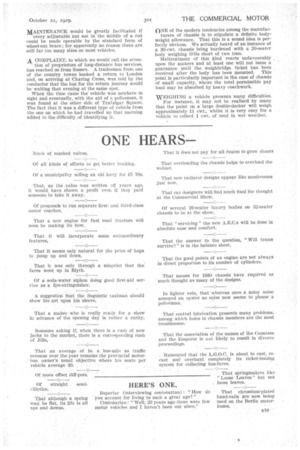LOOSE LEAVES
Page 44

Page 45

If you've noticed an error in this article please click here to report it so we can fix it.
ONE of the most
interesting persons in the commercial-vehicle industry is Mr. J. L. Milligan, B.Sc., 141.I.A.E., assistant to Mr. Shephard, managing director of Tilling-Stevens Motors, Ltd. Chatting with him, one finds that he is quite an encyclopmdia of interesting information and ideas and that he is blest with an excellent memory.
COMMERCIAL vehicles travel so quickly nowadays that one begins to question whether fans may not be dispensed with for some classes of work. At a road speed of 40 m.p.h. or more the headwind probably over-drives most fans. This leads one to consider whether the natural trend of design ought to be in the direction of arranging for adequate cooling in summer weather by adequate radiator capacity and water impeller—reducing the heat dissipation in cold weather by means of radiator shutters. For fast inter-town coaches and even for trunk-road plods motors we may see this tendency ere long.
MANY people in the trade have wondered why this year's German Show was cancelled. It was apparently due to pressure from the German agents, who considered that the show was merely becoming a boost for foreign vehicles and they were afraid that they would have difficulty in liquidating existing stocks of German make.
A BIG development in the protection of corrodible
metals would appear to lie in the process of spraying them with a coating of zinc, etc. It is claimed by the Metals Coating Co., Ltd., 22, Birchin Lane, London, P.C., that a zinc coating .004 in. thick .gives protection equivalent to hot-dip galvanizing. It presents the advantage that work of anysieaa be treated, in situ. Iron and steel can also be protected from scale to a remarkable degree by aluminizing. i318 WE were testing a new chassis the other day —one of those fine, heavy beasts which are capable of good speed and have excellent braking. By an oversight the front-wheel, brakes were not connected up and we very soon became aware of the fact. Our first brake test was made at a speed of 48 m.p.h.—the rear wheels stopped dead and, though the road was dry, we started a skid which looked like taking us through the hedge. Fortunately disaster was averted.
The front brakes were then adjusted and the experiment repeated. Not the suspicion of a skid this time—just that' head-over-heels' feeling which denotes a highly efficient braking s'ystem and perfect control.
ONE of our manufacturers of fire-engines has
missed a wonderful opportunity for advertisement, or at least that is so if there be any truth in a paragraph we read in a prominent daily paper the other day. There had been a fire, and the promptitude with which the nearest fire brigade had come to the rescue was subject for comment. The distance traversed was 15 miles and the time taken, according to the report we read, was five minutes. A very brief and simple calculation is -• sufficient to. show that this is equivalent to an average speed of 180 miles per hour!
DURING a recent visit to the Dennis works we
examined some repaired parts which looked practically new. We were told that they had been sand-blasted so as to remove any scratches or spanner marks. Such a process, of course, applies only to surfaces other than those used for bearings. The particular component we saw was a refaced bitch cone in aluminium. Impressions are important and the .user who receives a nicely finished job is bound to be-more satisfied. MAINTENANCE would be qreatly facilitated if every adjustable nut not in the middle of a rod could be made operable by the standard form of wheel-nut brace; for apparently no reason-there are still far too many sizes on most vehicles.
A COMPLAINT, to which we would call the atten tion of proprietors of long-distance bus services, has reached us from Sussex. A tradesman from one of the country towns booked a return to London and, on arriving at Charing Cross, was told by the conductor that the bus for the return journey would be waiting that evening at the same spot.
When the time came the vehicle was nowhere in sight and eventually, with the aid of a policeman, it was found at the other side of Trafalgar Square. The fact that it was a different type of vehicle from the one on which he had travelled up that morning added to the difficulty of identifying it. ONE of the modern tendencies among the manufac turers of chassis is to stipulate a definite bodyweight allowance. That this is a sound idea is perfectly obvious. We actually heard of an instance of a 30-cwt. chassis being burdened with a 20-seater body weighing little short of two tons.
Maltreatment of this kind reacts unfavourably _ upon the makers and at least one will not issue a ' guarantee until the weighbridge ticket has been received after the body has been mounted. This point is particularly important in the case of chassis of small capacity, where the total permissible pay load may be absorbed by heavy coachwork.
WEIGHING a vehicle presents many difficulties. For instance, it may not be realized by many that the paint on a large double-decker will weigh approximately l cwt., whilst it is very easy for a vehicle to collect 1 cwt. of mud in wet weather.




















































































































